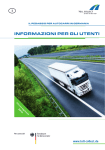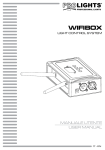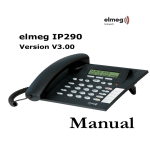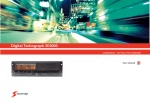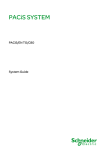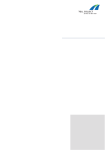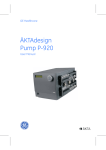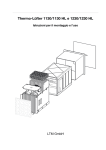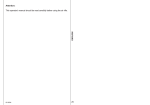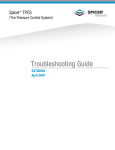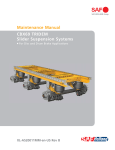Download USER INFORMATION
Transcript
GB TRUCK TOLL IN GERMANY USER INFORMATION on iti Ed d te 15 da 20 Up Commissioned by www.toll-collect.de Dear customer, Its location at the heart of Europe has made Germany the hub of international truck traffic, with thousands of vehicles from throughout Europe driving through the country every day. Transportation of goods is increasing constantly, which puts an enormous strain on the roads and means that investments must be made to maintain and expand them. To ensure that users contribute to these costs in an equitable way, in January 2005 the German government introduced a distance-based toll for all domestic and foreign trucks. From 01/10/2015 this toll applies for a gross vehicle weight of 7.5 tons or more. As part of a public private partnership, Toll Collect was commissioned by the German government to develop and set up a toll system that combines satellite positioning with stateof-the-art wireless technology. The charges are levied according to the distance travelled on toll roads, the number of axles and the emission class, including the air pollution costs. Toll Collect has created a system in which toll collection does not interfere with traffic flow. Unlike most conventional toll systems, the innovative technology makes it unnecessary for vehicles to reduce their speed, stop or stay within prescribed lanes. The result is an advanced and flexible system for German and European haulage companies to pay toll. The technical design of the Toll Collect system also means that it supports other toll systems. The TOLL2GO service has been set up in conjunction with ASFINAG, the Austrian toll operator. TOLL2GO enables the toll for vehicles weighing 7.5 tons or more to be paid in Austria using the Toll Collect On-Board Unit installed in the truck. This brochure provides all the information you need to know about truck toll in Germany from registration to log-on options to the toll statement. We hope you always have a good journey. Kind regards, Toll Collect 1 CONTENTS 1Overview............................................................................................................. 4 2 Toll requirement.................................................................................................. 6 2.1 Toll requirement regulations........................................................................... 6 2.1.1 Vehicles subject to toll........................................................................... 6 2.1.2 Toll-free or toll-exempted vehicles.......................................................... 7 2.1.3 Toll road network................................................................................... 8 2.2Responsibilities.............................................................................................. 9 2.2.1 Responsibility in public private partnership: Federal Republic of Germany and Toll Collect.......................................... 9 2.2.2Responsibility for enforcement and fine proceedings: Federal Office for Goods Transport (BAG)................................................ 9 2.2.3Responsibility for the toll road network: German Federal Highway Research Institute (BASt)................................. 10 3Registration........................................................................................................ 11 4 Log-on options.................................................................................................... 13 4.1 Automatic log-on using an On-Board Unit........................................................ 13 4.1.1 Installation of the On-Board Unit............................................................ 14 4.1.2 Operation of the On-Board Unit.............................................................. 16 4.2 Manual log-on................................................................................................ 17 4.2.1 Internet log-on....................................................................................... 17 4.2.2Log-on at a toll station terminal.............................................................. 18 2 4.3 Cancellation of manual log-on......................................................................... 21 4.3.1 Online cancellation................................................................................ 21 4.3.2 Cancellation at a toll station terminal..................................................... 22 4.4 Refund requests after expiry of log-on receipt period of validity..........................23 5 Toll amount......................................................................................................... 24 6 Payment methods............................................................................................... 28 6.1 Payment methods for registered customers..................................................... 29 6.1.1 Toll Collect credit system........................................................................ 29 6.1.2 Other payment methods......................................................................... 29 6.2 Payment methods for non-registered customers.............................................. 30 6.2.1Cash ..................................................................................................... 30 6.2.2Fuel card and credit card ....................................................................... 30 7 Invoicing for registered customers..................................................................... 32 7.1 Regular toll statement..................................................................................... 32 7.2 Exceptional statement.................................................................................... 33 7.3 Complaint: toll statement................................................................................ 33 7.4 Toll-related supplementary services................................................................ 33 8Enforcement........................................................................................................ 34 9 Questions and answers....................................................................................... 37 10 Service and contact............................................................................................. 44 3 1 Alternatively, the customer can log on for the section subject to toll using the manual log-on options at a toll station terminal or online. This data is also sent to the Toll Collect computing centre. OVERVIEW The Toll Collect toll system provides three log-on options: ▪▪ Automatic using an installed On-Board Unit (OBU), ▪▪ manual on the Internet, and ▪▪ manual at a toll station terminal. Automatic log-on is at the heart of the system: An On-Board Unit installed in the truck uses satellite signals (GPS - Global Positioning System) and additional supporting posi- tioning sensors to detect which route sections subject to toll the truck drives on. The On-Board Unit locates the position of the truck and can assign it to one of the route sections in the approximately 30,000 kilometre toll road network (both directions) at any time. The unit then uses the customer information for emission class and number of axles to calculate the charge and forwards this data to the Toll Collect computing centre using wireless technology. You have to register your company and its vehicles with Toll Collect before you can log on using the On-Board Unit or online. Registered customers can pay the toll using the payment methods provided by Toll Collect, particularly using credit or fuel cards. ment system to be adapted to constantly changing conditions. All data is handled in line with statutory data protection requirements. On 19 July 2011, the German Federal Trunk Road Toll Act (BFStrMG) came into force, replacing the motorway toll act as the legal basis for collection of the truck toll. The modification to the legal code states that the toll road network not only includes motorways but also federal trunk roads or sections of these. The legal framework for distance-based toll collection is pro- Log-on at a toll station terminal is available to all customers. Non-registered users can choose to pay by cash, fuel card or credit card. Further information on payment methods can be found in chapter 6. vided by: ▪▪ German Federal Trunk Road Toll Act (BFStrMG) of 12 July 2011 (BGBl. I p. 1378), most recently modified by article 1 of the law of 10 June 2015 (BGBl. I p. 922) ▪▪ Truck toll regulations for levying toll and regulating the provision of proof of correct toll payment and the refund- The customer service team is available to answer any questions on payment methods and on the entire toll system. ing of toll charges (German Truck Toll Regulations - LKWMautV) of 24 June 2003 (BGBl. I p. 1003), most recently modified by article 3 of the law of 5 December 2014 (BGBl. I p. 1980) To guarantee compliance with toll requirements, Toll Collect has provided the Federal Office for Goods Transport (BAG) with a comprehensive enforcement system. ▪▪ Toll extension regulations regulating the extension of the toll to specific segments of federal trunk roads (Toll extension regulations - MautStrAusdehnV) of 8 December 2006 (BGBl. I p. 2858), most recently modified by article 4 of the law of 12 July 2011 (BGBl. I p. 1378) As part of this enforcement, the Toll Collect computing centre checks for a valid log-on for all vehicles subject to toll. The enforcement system consists of automatic enforcement using enforcement gantries and portable enforcement units, as well as stationary and mobile enforcement using appropriate enforcement equipment and on-site enforcement. The combination of all these enforcement types guarantees adequate and continuous enforcement of compliance with toll requirements and enables the enforce- 4 ▪▪ Toll junction regulations regulating toll junctions for specific sections of federal trunk roads (Federal trunk road toll junction regulations - BStrMKnotV) of 9 August 2013 (BGBl. I p. 3218) The currently valid versions of all relevant legal regulations are available at www.gesetze-im-internet.de. 5 2 TOLL REQUIREMENT The German Federal Highway Research Institute (BASt) publishes updated details of the toll road network on the Internet. At www.mauttabelle.de there is a list of all motorways and federal trunk roads subject to toll for all vehicles subject to toll with a gross vehicle weight of 7.5 tons or more. 2.1 Toll requirement regulations 2.1.1 Vehicles subject to toll Vehicles subject to toll are defined as all commercial vehicles or vehicle combinations with a gross vehicle weight of at least 7.5 tons, which ▪▪ are intended exclusively for transportation of goods (1st alternative), or ▪▪ are being used for this purpose (2nd alternative). To justify a liability to pay toll, it is sufficient to be covered by one of the two alternatives set out in § 1 Paragraph 1 clause 2 no. 1 German Federal Trunk Road Toll Act (BFStrMG). Vehicles that are intended exclusively for transportation of goods (1st alternative) are subject to toll regardless of whether ▪▪ a journey is for private purposes, ▪▪ goods are actually being transported, ▪▪ transportation of goods is for commercial or internal purposes (intercompany traffic), or ▪▪ the affected vehicle is exempt from vehicle tax. Where any vehicles or vehicle combinations are used for charged or business-related transportation of goods (commercial goods transportation or intercompany traffic), a toll requirement exists as defined by the 2nd alternative. Details of how the gross vehicle weight of vehicle combinations is calculated can be found in § 34 Paragraph 7 of the German road traffic registration regulations (StVZO). Regardless of their country of origin, all customers must pay the toll for the distance travelled by their vehicles subject to toll on toll roads. 6 2.1.2 Toll-free or toll-exempted vehicles Vehicles or vehicle combinations with a gross vehicle weight below 7.5 tons are not subject to the truck toll. Vehicles or vehicle combinations with a gross vehicle weight of at least 7.5 tons which are not intended exclusively for transportation of goods and are not being used for that purpose are toll-free. In addition, as set out in § 1 Paragraph 2 of the German Federal Trunk Road Toll Act (BFStrMG), the following vehicles and vehicle combinations are toll-exempt: 1. Buses and coaches 2. Vehicles owned by the military, the police authorities, civil defence and disaster control vehicles, fire service and other emergency vehicles and federal government vehicles 3. Vehicles used exclusively for road maintenance and ‑operation, including road cleaning and winter services 4.Vehicles used exclusively in the carnival and circus trade 5. Vehicles used by non-profit-making or charitable organisations to transport emergency aid in serious humanitarian crises The prerequisite for toll exemption, except for buses and coaches or vehicles used by non-profit-making organisations, is that the motor vehicles must be externally identifiable as being intended for the relevant purpose. 7 2 TOLL REQUIREMENT Owners or keepers of toll-free or toll-exempted vehicles or vehicle combinations can register them with Toll Collect as not subject to toll on a voluntary basis. Registration is valid for two years and can be extended on request. Further information and the appropriate forms are available online at www.toll-collect.de or from our customer service team. All information provided on the form for registration of toll-exempt vehicles must be truthful and complete. The owner or keeper is responsible for the accuracy and completeness of the information for registration of a toll-exempt vehicle (self-declaration principle). Therefore, registration does not constitute recognition of toll exemption by Toll Collect or the Federal Office for Goods Transport (BAG). The responsible authorities are entitled to verify the accuracy of the information provided at any time. For the relevant requirements, refer to § 1 Paragraphs 1 and 2 of the German Federal Trunk Road Toll Act (BFStrMG). 2.1.3 Toll road network The toll requirement applies on all motorways, including service areas, unless explicitly excluded below, and starts when joining the motorway. According to the German Federal Trunk Road Toll Act (BFStrMG), motorways are all federal trunk roads formally designated as motorways. The toll requirement also applies to federal trunk roads that meet the following criteria: ▪ 8 The routes must be owned and maintained by the federal government and ▪ ▪ ▪ must have at least two lanes in each direction. Continuous structural separation of the two directions (central reservation) is required. This excludes at-grade intersections. In addition, the roads may not pass through towns, cities or villages. They must either be linked directly to a motorway, or indirectly linked to a motorway via another federal trunk road subject to toll or have a minimum length of four kilometres. ▪ ▪ ▪ ▪ The criteria listed do not apply to the following routes, which are also part of the toll road network and have been subject to the toll requirement since 1 January 2007: ▪ B 75 between A 253 motorway and A 7 motorway (Hamburg), ▪ B 4 north of A 23 motorway as far as Bad Bramstedt (Schleswig-Holstein and Hamburg), ▪ B 9 between the German / French border and the Kandel-Süd junction on the A 65 motorway (Rhineland-Palatinate). In accordance with § 1 Paragraph 3 no. 1 to 4 of the German Federal Trunk Road Toll Act (BFStrMG), the following sections of motorway have no toll requirement: section of A 6 motorway from the German / French border to the Saarbrücken-Fechingen junction in both directions, section of A 5 motorway from the German / Swiss border and the German / French border to the Müllheim/Neuenberg junction in both directions, sections of motorway for use of which a toll is levied in accordance with the applicable version of § 2 of the private financing of trunk roads act of 30 August 1994 (BGBl.I page 2243), sections of motorway that have only one lane and are not directly linked to the motorway network. An updated description of the toll road network can be found online at www.mauttabelle.de. 2.2 Responsibilities 2.2.1 Responsibility in public private partnership: Federal Republic of Germany and Toll Collect The legal toll regulations set out in detail the vehicles and routes for which a toll is to be paid, how it is to be collected and how com- pliance with the toll requirement is to be enforced. The way in which the responsibilities and procedures for enforcement of compliance with toll requirements are regulated is set out in chapter 8 “Enforcement”. The toll requirement regulations set out the framework within which Toll Collect operates as a contractor as part of a public private partnership. Toll Collect has set up the system for satellite-based toll collection and operates it as a trusted partner of the Federal Republic of Germany. In addition, Toll Collect has been appointed as a contractor to carry out the following tasks: ▪ identification of road usage subject to toll ▪ verification of correct toll payment ▪ retrospective collection of toll in certain cases As a private company, Toll Collect has no influence on the decision as to what vehicles are required to pay toll, which routes have a toll requirement, the level of toll rates and which emission classes are defined. These decisions are made by the legislator. 2.2.2 Responsibility for enforcement and fine proceedings: Federal Office for Goods Transport (BAG) The Federal Office for Goods Transport (BAG) is responsible for punishing violations of the toll requirement. If it is identified that the toll due for a vehicle subject to toll having driven on a toll road has not been paid, the charge for the distance travelled is col- 9 2 TOLL REQUIREMENT lected retrospectively. If the actual distance subject to toll travelled cannot be determined, the toll is levied retrospectively for a standard distance of 500 kilometres. For enforcement purposes the Federal Office for Goods Transport (BAG) records the required input data such as the licence plate number and toll rates. It then initiates fine proceedings. Fines can reach up to 20,000 euros. 3 REGISTRATION The first step to ensure convenient toll payment is registration of the company and its vehicles subject to toll with Toll Collect. Registered customers have various options for paying the toll. Further information can be found in chapter 6. Registered customers can choose from three log-on options. Automatic log-on using an On-Board Unit is the easiest and most convenient way to pay the toll. Manual log-on options are also available - either online or at a toll station terminal. After successful registration, the customer receives a welcome letter containing their user ID and two additional PIN mailings: ▪▪ The first mailing contains the master PIN, which is used to authenticate the registered customer. This is required for tele- 2.2.3 Responsibility for the toll road network: German Federal Highway Research Institute (BASt) The toll road network is the responsibility of the German Federal Highway Research Institute (BASt). For example, the BASt’s responsibilities include measuring the route sections that make up the toll road network. Continuously updating the toll road network (e.g. when new route sections are completed) is also the responsibility of the BASt. Updated details of the toll road network are published online at www.mauttabelle.de. 10 11 3 REGISTRATION phone contact with customer service, to change data and as the default password for initial registration when using Internet log-on. The second mailing contains the fleet PIN. This is valid for the entire fleet and makes it easier to log on at a toll station terminal using a vehicle card. Two activation codes are required for the initial login to the Toll Collect customer portal. These can be ordered using the contact form. Once the two mailings have been received, the web account can be activated. New customers receive their initial access data for the customer portal directly with their user registration. The user registration forms can be found on the Internet at www.toll-collect.de and can be completed directly online or downloaded to print and complete by hand. Alternatively, the forms can also be requested from customer service by telephone (refer to chapter 10 “Service and contact”). The Toll Collect customer portal provides a range of benefits: ▪▪ Faster registration of vehicles: As soon as registration is confirmed, customers can immediately have an On-Board Unit (OBU) installed by a service partner. ▪▪ Data for vehicles already registered can be changed more easily and synchronised to the On-Board Unit wirelessly. ▪▪ Current customer and vehicle data and the payment method can be viewed at any time. ▪▪ The documents must then be printed, signed and returned to Toll Collect by fax or post with a company stamp. Vehicles can also be registered quickly and easily in the customer portal. 4 LOG-ON OPTIONS The toll is only due when toll roads are used. The system that Toll Collect has set up for toll collection operates on this principle. The company provides customers with three log-on options: ▪▪ automatic log-on using an On-Board Unit (OBU) ▪▪ manual log-on on the Internet ▪▪ manual log-on at a toll station terminal 4.1 Automatic log-on using an On-Board Unit After registration, every customer can have an On-Board Unit installed in their vehicle. The OBU uses GPS satellite signals and other positioning sensors to detect the route sections subject to toll travelled and automatically calculates the toll to be paid based on the set vehicle data and the applicable toll rates. Customer portal The customer portal is a secure online area for registered Toll Collect customers. In this area, customers can see an overview of their current company and vehicle data. New vehicles can be registered and vehicle data already entered can be changed with just a few clicks. Vehicle data can be changed by selecting “Displaying and changing vehicles”. In addition to the emission class, the number of axles and the gross vehicle weight, the licence plate number, country code and vehicle identification number can also be changed. Once the required changes have been made, the customer receives a written confirmation. 12 13 4 LOG-ON OPTIONS Automatic log-on Satellite transmits location data (Global Positioning System, GPS) Destination Customer 1. Installation of On-Board Unit 2. Entering 3. GPS-based vehicle data identification of road segment 4. On-Board Unit identifies toll road segments 8. Toll Collect settles toll amounts with the customer The toll information is sent to the Toll Collect computing centre wirelessly in encrypted form. They then create the invoice (see chapter 7). Transparency is guaranteed: Every registered customer can use the toll statement or the detailed itemised journey list (selectable as an option for customers during user registration) to monitor the toll due and thus to check that the toll levied is correct. 4.1.1 Installation of the On-Board Unit The customer agrees installation of the OnBoard Unit with a service partner authorised by Toll Collect. These workshops specially selected and trained by Toll Collect can be found throughout Germany and in other European countries. A detailed list can be found on the Internet at www.toll-collect.de. The On-Board Unit is available free of charge and remains the property of Toll Collect when installed. The installation 14 5. Enforcement 6. O n-Board Unit (stationary calculates toll fees and mobile) 7. The payable amount is transmitted to the Toll Collect computer centre via wireless mobile communication costs and other expenses involved are paid by the customer. The installation time is generally no longer than four hours per vehicle. For a new vehicle, this time can be reduced if the customer requests that the truck is factory fitted with a cable set and an antenna for the On-Board Unit installation. As well as fitting of the On-Board Unit, installation involves the following steps: ▪▪ Personalisation of the On-Board Unit on site by the service partner (loading of vehicle and customer data) ▪▪ Routing of the antenna cable and installation of the antenna ▪▪ Connection to a suitable speed signal (e.g. tachograph) ▪▪ Connection to the vehicle electrical system ▪▪ Assembly of the On-Board Unit ▪▪ Test drive and customer briefing ▪▪ Confirmation of proper installation of the On-Board Unit on an installation certificate both by the customer and by the service partner Registered customers can currently choose from two different On-Board Unit models, subject to availability: ▪▪ Dashboard-mounted OBU: This OnBoard Unit is mounted directly on the dashboard. The On-Board Unit contains a DSRC module*, which is used to transfer On-Board Unit data to enforcement gantries, Federal Office for Goods Transport (BAG) enforcement vehicles and support beacons. It guarantees effective interaction (interoperability) with other toll systems. ▪▪ DIN-slot On-Board Unit: This type of OnBoard Unit is installed in a DIN slot, in a similar way to a car radio. During installation, a DSRC module is also attached to the windscreen. For both On-Board Unit types, a combined antenna is fitted on the roof of the vehicle. This antenna receives the GPS signal and transmits data wirelessly to the Toll Collect computing centre. Personalisation of the On-Board Unit involves loading the specific data for the truck, e.g. its emission class. The vehicle’s official licence plate number and country code are saved. This creates a unique assignment to the On-Board Unit. Where re- quired, this data can be changed directly with Toll Collect at a later date. Once the On-Board Unit has been installed, it is handed over to the customer. They receive a briefing from the Toll Collect service partner and a user manual. In return, the customer signs the installation certificate for the service partner to acknowledge acceptance. The following expenses have to be paid by the customer: ▪▪ the costs of installing the On-Board Unit ▪▪ the costs for removal in the event of the vehicle being decommissioned or sold, or if the business relationship with Toll Collect is terminated ▪▪ the costs of a change of licence plate number or for any data relevant for the toll to be changed by a service partner ▪▪ travel to and from the service partner and the time spent there to have the above work carried out * DSRC stands for “Dedicated Short Range Communication” = Short-range communication using infra-red or microwaves. 15 4 LOG-ON OPTIONS 4.1.2 Operation of the On-Board Unit The On-Board Unit is switched on automatically when the ignition is started. The driver must check the data entered (number of axles and gross vehicle weight) before every journey and must edit it if necessary. The settings from the last journey are retained. positioning is totally independent of the GPS positioning method. The results from satellite and dual positioning are continuously compared. The lengths of the route sections subject to toll have been specified by the German Federal Highway Research Institute (BASt) and are stored in the On-Board Unit. A fault with the On-Board Unit or the GB When the ignition has been started, the driver has checked the data and confirmed with “OK” and the9 green LED on the On9 Board Unit lights up, automatic toll collec9 tion for the relevant vehicle is activated. Further details can be found in the OnBoard Unit user manual. 1. on-Board unit (oBu) 2. oBu fault Keeping in the green zone DSRC module can lead to the Feder- Keeping in touch al Office for Goods Transport (BAG) Ensuring perfect contact stopping the customer as part of its Always there for you 9 enforcement activity. Information on 9 Advice sheet for An interference-free journey tem works even if there is a temporary loss or interference of the GPS signal. Digital encryption guarantees the security of provided in the “Keeping in touch” every log-on. initial login, the customer enters their user ID and master PIN. They then set a personal Internet login and password. After login, all of the customer’s registered vehicles are displayed. The customer can either select a saved vehicle or enter the data for another vehicle, e.g. a rented truck. They then set the start and end point for the route. The shortest route in the toll road network is then determined automatically from the data entered. The customer can either accept this or adapt the route to meet their requirements by entering up to four via points (i.e. junctions or motorway intersections the route should include). For journeys that include isolated stages (islands), several logons may be necessary. bulletin, which can be found online at www.toll-collect.de. www.toll-collect.de 16 Thanks to additional positioning sensors, the Toll Collect sys- correct use of the On-Board Unit is 9 blocked de To allow automatic toll collection, the OnBoard Unit is continuously supplied with positioning data by GPS signals. This enables the On-Board Unit to detect where the vehicle is and it then continuously compares this position with maps stored in the unit. To support this positioning in the On-Board Unit and thus to maximise the positioning accuracy, additional sensors are used. So-called dual positioning uses a gyroscope and the tacho signal to monitor vehicle movements and direction. Dual chapter 7 “Invoicing for registered customers”). Based on the route information, the toll rates and the saved vehicle data, the OnBoard Unit calculates the toll to be paid. The On-Board Unit stores this information and sends it wirelessly in encrypted form to the Toll Collect computing centre. The information is sent whenever a particular toll amount is reached or when a defined time has elapsed. If the unit is switched off at this time, the data is sent as soon as the unit is next activated. When the driver turns off the vehicle ignition, the OnBoard Unit is also switched off. In the Toll Collect computing centre, the toll to be paid is assigned to the customer based on the vehicle’s licence plate number and the company receives a regular – currently monthly – toll statement if any toll is due (for further information see 4.2 Manual log-on The alternative to automatic toll collection using an On-Board Unit is manual log-on online or at a toll station terminal. The log-on is possible up to three days before the start time, i.e. the beginning of the log-on receipt validity period. 4.2.1 Internet log-on The prerequisite for using the Internet log-on option is that the company must first be registered with Toll Collect. The customer can access the Internet Reservation System (IEBS) home page from www.toll-collect.de. The log-on is possible in German, English, French and Polish. No special software is required. The log-on requires just a few steps: For the The period of validity and the toll to be paid is then determined. If the customer agrees, they receive a log-on receipt that includes a log-on number. The driver can use this number to prove that the correct toll has been paid if checked by the enforcement authority. It is also necessary for cancellations. The customer can print out the log-on receipt or have it sent by e-mail. This document contains a security code, known as the digital signature, which verifies the authenticity of the document. 17 4 LOG-ON OPTIONS Manual log-on: Log-on via Internet Destination Customer 1. Log-on via Internet 2. Vehicle travelling on toll road Polish. If the driver has any questions, they can use the call button at any time to contact Toll Collect. They can then get the information they need directly from an advisor, either in German, English, French or Polish. 3. Enforcement (stationary and mobile) When the driver is satisfied with the route, they confirm it and select the preferred payment method. The system automatically calculates the latest time by which the journey has to end. This calculation takes into account the start time, the length of the journey and a time buffer for short breaks, traffic jams and other delays. However, the time window is designed to prevent multiple journeys with a single log-on. 4. Toll Collect settles toll amounts with the customer A toll atlas showing all toll station terminal locations is available from Mautatlas Toll Collect and can also be found at Only entire journeys can be cancelled online before the start of the period of validity. Partial cancellations are only possible at toll station terminals along the scheduled route. Protective measures are in place to prevent unauthorised log-on attempts: After an incorrect password has been entered several times, personal access is blocked and can only be unlocked by Toll Collect customer service. The SSL standard with a key length of 128 bit is used for secure transmission. Note: The routing method used with the manual log-on suggests routes within the toll road network and uses this as a basis for calculating the toll for the shortest route. Therefore, the route offered by the system may not be the shortest route. Customers who prefer an alternative route can register this route using individual stages. 18 4.2.2 Log-on at a toll station terminal All customers, whether registered or not, can log on manually at a toll station terminal. These are clearly marked “Toll Collect” and can be found in Germany and in neighbouring countries close to junctions, at truck stops, service areas and service stations. The log-on procedure is the same on all toll station terminals, regardless of whether they are indoor terminals inside a cash office or outdoor terminals set up in the open air. On a toll station terminal the log-on is possible in German, English, French and as well as a location search on a PC, al 15 20 is ie rte Au fla ge every toll station. A list of locations, tu This excludes toll-free network links. When using a log-on in the manual system, toll-free links make it easier to log on for preferred routes. The suggested route then includes both sections subject to toll and toll-free sections. Ak The customer has the option of entering a cost centre for internal cost allocation as part of the log-on. Gratisexemplar – Free copy – Exemplaire gratuit – Egzemplarz bezpłatny The log-on procedure on the terminal is similar to that for buying a train ticket. It is operated using a touch screen and a PIN keypad for the card payment. The driver enters all the relevant vehicle data or uses a vehicle card, sets the start date as well as the start point and destination of the journey. The toll station terminal then automatically calculates the shortest route within the toll road network. The driver can accept the suggested route or change the route by entering up to four intermediate points, known as “Via points” that the route should include. Changes can be made using the “Change route” button and then selecting on a map. For example, beginning at the start point the driver should select the most important motorway intersections as via points on the map. For journeys that include isolated stages (islands), several log-ons may be necessary. Toll Atlas Atlas du Péage Atlas Myta smartphone or tablet, are available online at www.toll-collect.de. The driver must organise the log-ons so that they can comply with the statutory driving and rest times. Starting the journey as close as possible to the beginning of the validity period of the log-on is recommended. Finally, the driver receives a log-on receipt, or for card payments a payment receipt. This receipt contains the following information: ▪ the vehicle data ▪ the selected route ▪ the length of the journey ▪ the toll amount ▪ the log-on number, and ▪ the period of validity For a log-on with cash payment on an indoor terminal, the terminal issues two receipts – a log-on receipt for the customer 19 4 LOG-ON OPTIONS Manual log-on: Log-on at a toll-station terminal Destination Customer 1. Log-on at a toll station terminal 2. Vehicle travelling on toll road and a cash receipt for the toll-station operator. After payment, the driver receives the log-on receipt back from the cashier, completed with the log-on number. On outdoor terminals, cash can be paid directly. The machines only accept banknotes, not coins. Change is paid in coins along with a receipt. Cashless payment direct on the terminal is possible on both indoor and outdoor terminals. Non-registered customers have the option of paying with an accepted credit card or a fuel card that is authorised for the manual log-on method. Registered 3. Enforcement (stationary and mobile) customers can also pay using the vehicle card and the payment method stored on it. In this case, only a log-on receipt is issued. Invoicing is then carried out according to the agreed payment method. The terminals are connected to the Toll Collect computing centre. This means that the log-on data is sent directly to Toll Collect after the log-on and the enforcement system can identify whether the vehicle is correctly logged on for the relevant toll route at the corresponding time. Log-ons can be cancelled before the beginning of the log-on receipt period of va- lidity at any toll station terminal and partially cancelled during the period of validity at toll station terminals along the booked route (for the distance not yet driven). Detailed information about cancellations can be found in chapter 4.3 “Cancellation of manual log-on”. There is a charge for partial and full cancellations. This excludes immediate cancellations within 15 minutes at the issuing toll station and within five minutes after an Internet log-on. For all other cancellations, a fee of 3 euros is charged. Cancellation is not possible if the amount to be refunded or the available credit is less than or equal to the cancellation fee of 3 euros. Also refer to the information at the end of chapter 4.2.1 “Internet log-on”. 4.3 Cancellation of manual log-on Manual log-ons can be cancelled. This can be done in the following ways: Journeys whose period of validity has not yet begun can be cancelled online (for registered customers) and at any toll station terminal (for registered and non-registered customers). A cancellation may be rejected due to input errors or temporary technical faults on the toll station terminal. If there is a technical fault, the amount paid is refunded to the customer after submission of the “Complaint/cancellation log-on receipt” form and inspection by Toll Collect; in the case of input errors, no refund is given. Therefore, the driver should first use the 20 call button on the terminal to speak to Toll Collect and clarify whether there has been an input error. The customer can obtain a complaint form directly at the location of the manual log-on or download it online at www.toll-collect.de. Journeys can no longer be cancelled with Toll Collect once the log-on receipt period of validity has elapsed. In this case a refund can only be obtained from the Federal Office for Goods Transport (BAG) (see chapter 4.4 “Refund requests after expiry of log-on receipt period of validity”). Note: A log-on can only be amended by cancelling and logging on for the new route. 4.3.1 Online cancellation A route booked online can be cancelled before the period of validity begins. To do this, select the “Cancellation” function, enter the log-on number of the route to be cancelled and confirm. The log-on is then flagged as invalid in the toll system, which means that the log-on receipt and the logon number are no longer valid. The refund 21 4 LOG-ON OPTIONS is made as a credit using the payment method selected by the customer during registration. Partial cancellations of journeys subject to toll that have already been started can only be made at a toll station terminal along the booked route. 4.3.2 C ancellation at a toll station terminal The cancellation procedure is the same at all toll station terminals, regardless of whether they are indoor or outdoor terminals. A customer can fully cancel a route booked on a toll station terminal at any toll station terminal and get a refund for the toll charge paid, provided the full cancellation is made before the period of validity begins. The refund amount calculation is based on the distance subject to toll not yet travelled starting from the location of the toll station terminal at which the cancellation is made to the destination of the selected route. To do this, the customer selects the “Cancel” function and inserts the log-on receipt. For a partial cancellation, the driver specifies a new destination on the original route. This destination must be between the location of the toll station terminal at which the cancellation is made and the original destination. The toll for the distance between the new destination entered and the original destination is then refunded. If the toll was paid in cash, the customer receives a ticket, against which the toll to be refunded is paid out at the cash desk. If the cancellation is made at an outdoor terminal, the amount to be refunded (minus the cancellation fee) is paid out in cash in euro coins. 4.4 Refund requests after expiry of log-on receipt period of validity After expiry of the log-on receipt period of validity, the customer can request a refund from the Federal Office for Goods Transport (BAG). Evidence must be provided that there are genuine reasons why a prior claim could not have been made. This must be done within two months of the end of the log-on receipt period of validity. The corresponding form can be downloaded from the Internet at www.bag.bund.de or requested from the following address: Bundesamt für Güterverkehr (BAG) Werderstraße 34 50672 Cologne Germany The refund procedure at the Federal Office for Goods Transport (BAG) is subject to charges. If the toll was paid by card, the corresponding card should be inserted in the terminal and the refund is made using this payment method. During the period of validity, the customer can only make a full cancellation of the route booked on a toll station terminal at a toll station terminal assigned to the start point of the booked route. For partial cancellation, route sections subject to toll not yet travelled can be cancelled at a toll station terminal along the booked route. 22 23 5 TOLL AMOUNT The toll is determined by the distance travelled by the vehicle or vehicle combination on roads subject to toll and a toll rate per kilometre, which takes into account infrastructure costs and the costs of air pollution caused. The proportion of the toll rate made up of infrastructure costs differs for trucks with two axles, three axles, four axles and five or more axles. The proportion of the toll rate made up of costs for air pollution caused is based on the emission class. Every vehicle is assigned to one of six categories A, B, C, D, E and F according to its emission class. Specifying the emission class is the responsibility of the customer who, according to the self-declaration principle, is obliged to provide correct data relevant for the toll. For vehicles that do not belong to any emission class or emission class S1 the toll rates for category F apply, for vehicles in emission class S2 the rates for category E. Vehicles in emission class S2 with a particulate reduction system from particulate reduction class* 1, 2, 3 or 4 use the lower toll rates for category D. For vehicles in emission class S3 combined with particulate reduction class* 2, 3 or 4 the rates for category C apply. For vehicles in emission classes S5 and EEV class 1 the category B rates are applicable and for vehicles in emission class S6 the rates for category A. Procedure for registered vehicles without On-Board Unit The next time the On-Board Unit is started up, the change request in the customer portal is then indicated by “NEW VEHICLE DATA REQUESTED” appearing for a short time in the On-Board Unit display. The message “VEHICLE DATA UPDATE” does not appear until after the next ignition cycle, and the changed data is displayed for a few seconds. Once the change has been made in the Toll Collect systems, the customer receives a written confirmation from customer service. As soon as the new data is loaded in the On-Board Unit, the kilometres travelled are invoiced at the lower rates. After installation of a particulate reduction system in a truck registered with Toll Collect, the customer can take advantage of the lower toll rates by changing the vehicle data. All registered customers can access the customer portal to do this. Once the change has been made, the customer receives a confirmation by e-mail and by post. Procedure for registered vehicles with On-Board Unit TOLL-EasyChange is available to customers for changing the vehicle data for a truck with an On-Board Unit. Once the change request has been issued, the changed vehicle data is simply transferred to the On-Board Unit wirelessly. In addition to the vehicle data (emission class, number of axles and gross vehicle weight), TOLL-EasyChange can also be used to change the licence plate number and the country code. This prevents workshop costs and downtimes. In the period before the change has been completed, the customer can pay their toll at a toll station terminal or using the Internet Reservation System by manually entering the vehicle data or they can request a refund of any excess toll paid from the Federal Office for Goods Transport (BAG). * Particulate reduction classes are retrofitting standards to lower particulate emissions. Changes to the vehicle data can also be made conveniently in the customer portal. 24 25 5 TOLL AMOUNT Determination of the emission class for a vehicle subject to toll Toll rates per kilometre from 01 October 2015 For domestic vehicles registered in Germany using standard EU vehicle documents, the emission class can be determined by the text in section 14 or from the 3rd and 4th digits of the code number in 14.1. In older vehicle documents, the code number entered under section 1 should be used. In this case, the 5th and 6th digits of the code number are relevant. Further information about the individual emission classes can be found in the “Guide for determining the emissions classes of heavy commercial vehicles” online at www.toll-collect.de. Category A B Proportion of toll rate (in cents) Costs for air pollution 0 2.1 Emission classes according to the German Federal Trunk Road Toll Act (BFStrMG) Category A Emission class Euro emission class S6 Euro 6 Category B EEV class 1, S5 EEV 1, Euro 5 Category C Category D S4, S3, S3 with S2 with particulate particulate reduction class* 2 reduction class* 1 Euro 4, Euro 3, Euro 3 + Euro 2 + particulate particulate reduction class* reduction class* 2 1 Category E Category F S2 S1, no emission class C D Euro 2 3.2 6.3 Euro 1, Euro 0 * Particulate reduction classes are retrofitting standards to lower particulate emissions. For category D, particulate reduction class 1 or E 7.3 higher is required; for category C, particulate reduction class 2 or higher is required. F 8.3 Number of axles** Proportion of toll rate (in cents) Costs for infrastructure Toll rate (in cents) 2 8.1 8.1 3 11.3 11.3 11.7 4 11.7 5 or higher 13.5 13.5 2 8.1 10.2 3 11.3 13.4 4 11.7 13.8 5 or higher 13.5 15.6 2 8.1 11.3 3 11.3 14.5 4 11.7 14.9 5 or higher 13.5 16.7 2 8.1 14.4 3 11.3 17.6 4 11.7 18.0 5 or higher 13.5 19.8 2 8.1 15.4 3 11.3 18.6 4 11.7 19.0 5 or higher 13.5 20.8 2 8.1 16.4 3 11.3 19.6 4 11.7 20.0 5 or higher 13.5 21.8 **The tandem axle counts as two axles, the tridem axle counts as three axles. Lift and retractable axles are always taken into account, regardless of whether a vehicle axle is being used or is lifted during transportation, in other words has no road contact. The road user subject to toll must prove the accuracy of all relevant data for toll collection when requested by the German Federal Office for Goods Transport (BAG) by showing appropriate documents (section 5 of the German Federal Trunk Road Toll Act (BFStrMG) in conjunction with section 7 of the German Truck Toll Regulations (LKW-MautV)). For all trucks registered in Germany, the emission class can be proven by the vehicle licence, part I of the vehicle registration certificate or the vehicle tax document (section 8 of the German Truck Toll Regulations). For vehicles registered outside of Germany, time-based presumptions apply if the emission class cannot be proven in another way, in particular with documents attesting the fulfilment of certain environmental requirements in ECMT transport (European Conference of Ministers of Transport) (section 9 of the German Truck Toll Regulations). The road user subject to toll is responsible for demonstrating and proving all data relevant for toll collection. Failure to provide proof will be penalised with a fine. 26 27 6 PAYMENT METHODS There are various ways to pay the toll. The following payment methods are available: Non-registered customer ▪ Cash ▪ Credit card ▪ Fuel card Registered customers Toll Collect credit system ▪ dvance transfer (settlement by credit A account) ▪ ayment by SEPA direct debit (direct debit P prepaid service) Other payment methods ▪ Credit card ▪ Fuel card ▪ LogPay 6.1 Payment methods for registered customers Payment by SEPA direct debit (direct debit prepaid service) Customers who register with Toll Collect can take advantage of various methods for paying their toll. Toll Collect adjusts the customer’s credit in their credit account daily according to their current distance travelled. Before the credit is used up, Toll Collect requests a direct debit payment from the customer’s bank account. The customer can choose whether they want to top up their credit account for the next 14 or 30 days. 6.1.1 Toll Collect credit system If the customer wants to pay the toll directly to Toll Collect, they can choose from the following options: Advance transfer (settlement by credit account) The customer pays an amount corresponding to the expected travel distance in advance to their Toll Collect credit account, which is continuously debited to settle the toll due. The transfer is made to the following bank account, specifying the user ID as the “Reference”: Recipient: Toll Collect GmbH Bank: Helaba IBAN: DE88 3005 0000 0001 6401 19 BIC/Swift code: WELADEDD The credit balance can be requested by telephone from customer service at any time, but note that the actual credit may be lower as a result of delayed charging of toll due to technical conditions at the time of the enquiry. Advantages: ▪▪ No effort to monitor the credit balance ▪▪ The amount debited is based on individual travel distance ▪▪ Avoids follow-on costs due to lack of credit ▪▪ Advance information on amount and time of debits by e-mail Further information is available at www.toll-collect.de or directly from customer service. 6.1.2 Other payment methods When the toll is paid through a payment services provider, the provider guarantees to Toll Collect that the toll payments due will be settled up to the agreed credit limit. Credit cards To pay the toll using a credit card, the customer must first set up a contract with a credit card provider accepted by Toll Collect. The customer then pays the toll to Toll Collect as part of the existing credit card 28 29 6 PAYMENT METHODS contract with the provider. Depending on the provider, prepaid and post-paid options are available, i.e. the toll is either paid before or after using the toll road network. Fuel cards The toll can also be paid using a fuel card. First of all Toll Collect asks the fuel card issuer selected by the customer during registration for a sufficient limit to cover the customer’s monthly mileage plus a safety margin. As soon as the requested limit has been confirmed, Toll Collect sets up the preferred payment method. When using this method the payments are actually made according to the terms agreed between the customer and the fuel card issuer. LogPay plan To pay the toll using a LogPay plan, the customer must first set up a LogPay contract with DVB Bank S.E. As part of this contract, the toll is then paid by a SEPA direct debit mandate by LogPay Financial Services GmbH (formerly DVB LogPay GmbH) from the customer’s bank account. To qualify for a LogPay plan, the customer must have a sufficient credit rating, which is calculated based on monthly mileage with a safety margin. The toll is debited from the customer’s bank account after use of the toll roads. Further information is available on the provider’s website. When paying the toll through a payment services provider: If the payment services provider selected 30 during registration withdraws the payment guarantee to Toll Collect, this leads to a change in the selected payment method to settlement by credit account or to another payment method requested by the customer after registration. www.toll-collect.de or requested from customer service. Note: When using the vehicle card at a toll station terminal and selecting this as the payment method, the payment method agreed with the registered customer is used for payment of the toll. 6.2 Payment methods for non-registered customers Non-registered customers can pay their toll directly on the toll station terminal. 6.2.1 Cash The toll can be paid in euros as well as in the national currency at the relevant location at the toll station terminals. If change is due, this is paid in euros. For outdoor terminals, note that payment is only possible using notes, either in euros or in the relevant national currency. 6.2.2 Fuel card and credit card Every customer can pay their toll without cash at all toll station terminals. The fuel and credit cards accepted by Toll Collect can be checked online at any time at 31 7 INVOICING FOR REGISTERED CUSTOMERS itemised journey list is a detailed list of the journeys subject to toll made, enabling the toll amounts to be precisely tracked. Explanations of the toll statement and the itemised journey list can be found online at www.toll-collect.de. 7.2 Exceptional statement 7.1 Regular toll statement Every registered customer receives a toll statement on a regular basis, currently once a month. This shows the total toll amount incurred in an invoicing period. Under some circumstances, a toll statement may also in- clude toll charges due from a previous invoicing period but not yet paid. The toll statement is sent by post or by e-mail as a PDF file. On request, the customer can also receive a free itemised journey list, which is also sent by post or e-mail. The In addition to the regular toll statement, it is possible that exceptional statements will be issued. There are currently two reasons for issuing an exceptional statement: ▪▪ If the user account reaches a negative figure: The statement is marked “Sonderaufstellung” (exceptional statement). ▪▪ If the payment method is changed: The statement is marked “Sonderaufstellung nach Zahlwegwechsel” (exceptional statement after change of payment method). In both cases, the exceptional statement contains the same information as the regular toll statement. Further details can be found in Toll Collect’s general standard terms and conditions, which are available online at www.toll-collect.de. 7.4 Toll-related supplementary services Toll-related supplementary services are all Toll Collect services used in the invoicing period, e.g. duplicates of toll statements or itemised journey lists. Any claims for compensation, e.g. for the loss of an On-Board Unit, are also invoiced as toll-related supplementary services. Further information on toll-related supplementary services and the associated prices can be found in the service description and price list, both of which are at www.toll-collect.de. These services are always invoiced separately. The invoice is sent by post. Payment is normally made using the payment method agreed with the customer (except for settlement by credit account). 7.3 Complaint: toll statement If there are any queries relating to the toll statement, customers can contact Toll Collect customer service in writing or by telephone. Complaints must be made within two months of receipt of the toll statement and must be in writing. Toll Collect provides a form for this purpose. It can be downloaded from www.toll-collect.de or requested from customer service. 32 33 8 ENFORCEMENT The enforcement system monitors correct payment of the toll and compliance with the regulations set out in the German Federal Trunk Road Toll Act (BFStrMG). The associated tasks are split between Toll Collect and the Federal Office for Goods Transport (BAG). Toll Collect provides the required technology for enforcement, such as enforcement gantries and the equipment used in Federal Of- fice for Goods Transport (BAG) enforcement vehicles. The number and locations of enforcement gantries are stipulated by the German government. In cases where an enforcement gantry is used to detect that the toll has not been properly paid, Toll Collect also operates the retrospective collection procedure. On the other hand, it is the Federal Office for Goods Transport (BAG)’s task to initiate civil ▪▪ Stationary enforcement: Alternatively, the data for potential toll violators can be sent to Federal Office for Goods Transport (BAG) employees parked further along the road from an enforcement gantry, who can then pull over the relevant vehicles from moving traffic and carry out checks. This enables the Federal Office for Goods Transport (BAG) employees to immediately clarify the situation and to levy retrospective toll and fines on the spot. ▪▪ Mobile enforcement: Around 300 mobile Federal Office for Goods Transport (BAG) teams enforce correct payment of the toll around the clock. This guarantees comprehensive and flexible enforcement over the entire toll road network. The mobile enforcement teams operate in a similar way to the enforcement gantries and identify whether a truck has an On-Board Unit and is part of the automatic toll collection scheme and, if so, whether the settings are correct. If they establish that a truck is not using an On-Board Unit for automatic toll collection, the enforcement team compares the vehicle’s licence plate number with the manual log-on data in the central database. If there is any doubt about correct payment of the toll, the vehicle is pulled over at the next parking area. If the suspected toll violation is confirmed, the Compliance with the toll requirement is enforced as follows: ▪▪ 34 To ensure more effective and flexible enforcement of compliance with the toll requirement, a portable enforcement unit is used, which operates as a portable enforcement gantry. Because the enforcement unit can be set up and dismantled quickly, unexpected enforcement checks can be made. offence proceedings in case of violations of the German Federal Trunk Road Toll Act (BFStrMG), such as failure to pay, incomplete payment or late payment of toll, and to set fines. Automatic enforcement: A total of 300 permanently installed enforcement gantries register approaching vehicles and as traffic is flowing they check whether the trucks subject to toll have a correct log-on in the system. If an On-Board Unit is installed and is activated, the gantry checks whether it is set correctly. For vehicles subject to toll, the licence plate number is scanned and compared with the data stored in the Toll Collect computing centre. If no log-on is identified, Toll Collect conducts the necessary investigations and any retrospective toll collection. Toll Collect must forward any information relevant to the proceedings to the Federal Office for Goods Transport (BAG), where it is evaluated. If there is a correct log-on, the vehicle data is immediately deleted. 35 8 ENFORCEMENT Federal Office for Goods Transport (BAG) enforcement personnel can retrospectively collect the toll on the spot and initiate civil offence proceedings. Before continuing their journey, drivers of foreign vehicles must pay a bond amounting to the unpaid toll plus the expected fine including additional costs. ▪▪ On-site enforcement: Federal Office for Goods Transport (BAG) employees also carry out on-site enforcement across Germany in the form of spot checks. This enforcement is partially based on random selection and partially where there is a specific suspicion. They check on-site whether the toll has been correctly paid in the past. This is done by scrutinising freight documents, fuel receipts, charts etc. In all cases, the Federal Office for Goods Transport (BAG) evaluates all information relevant to enforcement and initiates fine proceedings where appropriate. Fines of up to 20,000 euros can be imposed. 9 QUESTIONS AND ANSWERS Here you will find a selection of frequently asked questions with the relevant answers. A more detailed list can be found on the Internet at www.toll-collect.de. Questions about registration What happens if I have forgotten to select a particular payment method during registration? If you have not selected a payment method in the registration form, settlement by credit account is set as your default pay- Toll enforcement is carried out round the clock on all sections of the toll road network. If correct payment of the toll cannot be verified, the toll for the distance subject to toll actually travelled is retrospectively collected. Where this actual distance cannot be established, the toll is collected retrospectively for a distance of 500 kilometres per journey. 36 37 9 QUESTIONS AND ANSWERS ment method. Changes to the payment method are possible at any time once registration is complete. To do this, send the completed and signed “Payment method with payment guarantee, e.g. credit card”, “Payment method fuel card” or “Direct debit prepaid service” form, which you can download from www.toll-collect.de, to Toll Collect customer service. Can I make changes to the information I enter at registration at a later date? You can change the method by which the toll statement is sent or the payment method according to your preferences. To do this, depending on the nature of the change either complete the “Change address and services”, “Payment method with payment guarantee, e.g. credit card”, “Payment method fuel card”, “Payment method settlement by credit account” or “Direct debit prepaid service” form. The corresponding form can be found on the Internet at www.toll-collect.de. Who do I contact if I want to change the data I entered during registration at a later date? Please notify customer service of all changes as soon as possible in writing. We can then deal with your changes immediately. You can also change your contact data, such as the address, telephone number, contact name or e-mail address on the telephone by providing the master PIN. If there is any change to your payment method, the legal form of your company or, in terms of your vehicles, the vehicle data relevant for toll and/or the official licence plate number/country code, we require this information in writing using the 38 relevant forms: ▪▪ “Change address and services” ▪▪ “Payment method with payment guarantee, e.g. credit card” ▪▪ “Payment method fuel card” ▪▪ “Payment method settlement by credit account” ▪▪ “Direct debit prepaid service” ▪▪ “Change of company name/legal form, transfer of contract” ▪▪ “Change vehicle data for vehicles registered with Toll Collect” your OBU in the reception area*. This allows you to avoid workshop costs and downtimes. The corresponding form can be found on the Internet at www.toll-collect.de. I would like to receive my toll statement by a different method in future. Who do I contact? If you have any questions of this type, contact Toll Collect customer service using the “Change address and services” form. The form can be found on the Internet at www.toll-collect.de. However, you can also change the delivery method on the telephone by providing your master PIN. How can I make changes to the information I entered at vehicle registration at a later date? Regardless of whether or not your vehicle is equipped with an On-Board Unit, if your vehicle data changes, e.g. number of axles, emission class, licence plate number, use the customer portal. If you want to change the official licence plate number and/or country code, we also require a copy of the vehicle registration certificate, section 1 (vehicle licence). As soon as the change has been implemented in the Toll Collect systems, you will receive a confirmation from customer service. For vehicles with On-Board Units, the requested changes will be transferred to the installed On-Board Unit wirelessly. With the customer portal and TOLL-EasyChange, Toll Collect makes it easier for you to change the vehicle data for a vehicle with On-Board Unit installed. Your requested changes are then transferred wirelessly to You will find more details in the “Guide to changing vehicle data”, which is available online at www.toll-collect.de. * The data is transferred when the vehicle is in the following states: Belgium, Denmark, France, Italy, Luxembourg, Nether- available free of charge from Toll Collect on request, shows each individual journey with precise details of the start point, destination, distance travelled etc. How frequently is toll invoiced? As a registered customer you regularly - currently once a month - receive a statement showing the toll incurred in an invoicing period. lands, Austria, Poland, Switzerland, Spain, Czech Republic and Hungary. uestions about payment methods Q and invoicing An On-Board Unit is installed in my vehicle. How is the toll invoiced? The key issue for you as a member of the automatic toll collection system is the On-Board Unit installed in the truck. This On-Board Unit uses GPS positioning to determine the positioning data for the individual route sections driven by the vehicle. This data is transmitted wirelessly to the Toll Collect computing centre and is compiled into journeys. Toll Collect lists this data and sends you a toll statement as an overview of all journeys subject to toll. The “itemised journey list”, which is How is the invoicing period defined? As a customer, you have a general obligation to pay the toll calculated to Toll Collect in advance based on the details you provide and using your selected toll collection method (advance payment obligation in accordance with § 669 of the German civil code (BGB)). As a registered customer you receive a periodic summary of your journeys made during an invoicing period. This invoicing period is currently set at one month. However, a toll statement may also include journey data from previous invoicing periods. But duplicate invoicing is not possible. Can I decide when I want to receive my toll statement? Toll Collect spreads the invoices to all customers evenly over an invoicing cycle/ month. As with other technically based invoicing processes in public transportation and for telecommunications providers and energy suppliers, for example, it is not possible to accommodate individual date preferences on technical grounds. Every customer receives their toll statement regularly, currently once a month. This enables you to incorporate them into your operational processes. 39 9 QUESTIONS AND ANSWERS Why is the “invoice” from Toll Collect called a toll statement? The truck toll is a charge levied by the Federal Republic of Germany for the use of motorways and certain federal trunk roads. The customer uses Toll Collect to pay the toll for them. After completing this task, Toll Collect notifies the customer of the toll amounts incurred and paid. This information is provided in the toll statement. The toll statement is therefore not an “invoice” as defined under VAT legislation but is a “statement of account” as defined in § 666 of the German civil code (BGB). Why does the Toll Collect toll statement not include VAT? Toll is not subject to VAT. I have heard that you can enter a cost centre in the On-Board Unit when starting a journey. How does this benefit me? Entering the cost centre in the On-Board Unit allows you to allocate the journeys to different cost centres. This assignment is included in the itemised journey list. I would like to switch to a payment method with payment guarantee (credit card, LogPay plan, fuel card). Do I have to arrange a contract with the payment services provider first? Yes, you must arrange a contract with the relevant payment services provider. The contract documents and further information on the terms of the agreement can be requested directly from the selected payment services provider. You can then register with Toll Collect using the “User registration” form, speci- 40 fying the payment method, or in the case of a change of payment method you can initiate the change using the “Payment method with payment guarantee, e.g. credit card”, “Payment method fuel card”, “Payment method settlement by credit account” or “Direct debit prepaid service” form. I am a registered customer and I have selected a payment method with payment guarantee to pay the toll. If I log on a route on a toll station terminal as a oneoff, how do I pay for it? If you want your log-on to appear on your toll statement, you must select the vehicle card for payment. This selects the payment method you set during registration. How much time do I have to pay the toll charge? As a customer, you have a general obligation to pay the toll calculated in advance based on the details you provide and using your selected toll collection method. Depending on the payment method, specific periods may be applicable for when the amount is debited from the account (e.g. for credit cards or fuel cards). I use the Toll Collect “settlement by credit account” payment method. What happens if my credit account balance is insufficient? In this case - where fitted - the On-Board Unit is blocked. An Internet log-on is then no longer possible. You can only log on your journeys manually at a toll station terminal and you must pay the toll amounts due immediately. In this case, the vehicle card cannot be used as a payment method. I use one of the “other payment methods”. What happens if my payment services provider withdraws the credit facility granted? In this case, your payment method is changed to settlement by credit account and you will receive a corresponding notification from Toll Collect. If fitted, the OnBoard Unit will also be blocked. An Internet log-on is then no longer possible. You can only log on your journeys manually at a toll station terminal and you must pay the toll due immediately. In this case, the vehicle card cannot be used as a payment method. As soon as you have paid a sufficient amount into your credit account, the On-Board Unit is unlocked. Internet logons and payments using the vehicle card at a toll station terminal are then possible again. Questions about the automatic procedure What should I do if the On-Board Unit is stolen from my truck or is unusable after an accident? If the On-Board Unit has been stolen or can no longer be used due to an accident, send a written loss report to Toll Collect customer service as soon as possible. Toll Collect will deactivate the stolen OnBoard Unit to prevent any misuse of the unit. You can have the unit blocked immediately over the telephone by providing your master PIN. This procedure has been put in place for your own security. If the On-Board Unit in my truck malfunctions, what do I do? If the On-Board Unit malfunctions during a journey, you are obliged to log on manually without delay. This may mean that you have to leave the route subject to toll at the next exit. Log-on is possible at service stations when entering or leaving the motorway, at truck stops, service areas and border crossings using a toll station terminal and can also be carried out online by your office. In such cases, switch the On-Board Unit to manual logon. The message “AUTOMATIC COLLECT INACTIVE” must be shown on the display and the red LED must light up. In your own interest, contact a Toll Collect service partner as soon as possible to arrange inspection of the On-Board Unit. The toll atlas, the directory of toll stations and service partners, is useful here. However, the locations can also be found online at www.toll-collect.de. If the error message “OPERATING DATA INVALID” appears, what should I do? The “OPERATING DATA INVALID” message appears if no valid operating data for the automatic toll collection system is available when starting up the On-Board Unit. The red LED on the unit lights up. The On-Board Unit is not ready for operation. Before driving on a toll route, stop and restart the ignition. If the message is still displayed, set the unit to “TOLL COLLECTION MANUAL” and log on for the route using a manual log-on. After around four hours with the ignition on inside Germany, stop and restart the ignition again. If the “OPERATING DATA INVALID” message still appears after doing this, contact a Toll Collect service partner. 41 9 QUESTIONS AND ANSWERS What happens to the On-Board Unit if I sell or scrap my truck? The On-Board Unit remains the property of Toll Collect after installation in the vehicle. Therefore, you should drive to a Toll Collect service partner and have the On-Board Unit removed. You then have to deregister the vehicle with Toll Collect customer service. You can only deregister on the telephone by specifying your user ID, the licence plate number and the master PIN. To deregister in writing, use the “Deregistration of a vehicle without an On-Board Unit (OBU)” form, which you can download from www.toll-collect.de or request from customer service. There is a charge for removal of the OnBoard Unit. We may make a claim for damages for On-Board Units returned to Toll Collect that have not been removed by a service partner. Does the Toll Collect system also support toll systems in other countries? The Toll Collect system is designed to provide the technical framework to support other toll systems. With the TOLL2GO service, Toll Collect and ASFINAG, the operator of the toll system in Austria, allow interaction between a microwave-based toll system and a satellite-based toll system. TOLL2GO enables the toll for trucks weighing 7.5 tons or more to be paid in Austria using the Toll Collect On-Board Unit. The service is particularly attractive to transport companies whose trucks frequently travel in both Austria and Germany. 42 Questions about the manual log-on How do I find the toll station terminals? The locations can be found on the Internet at www.toll-collect.de and in the toll atlas. The toll station terminal is defective or closed. Who do I contact? If a toll station terminal on which you want to log on has a fault, or if the location is closed, every customer has an obligation to use the nearest available toll station terminal for the log-on. Questions about enforcement What is the purpose of the enforcement gantries? The enforcement gantries check whether the vehicles driving past are subject to toll and whether the toll requirement has been complied with, i.e. whether the truck has been logged on properly. Any suspicious cases arising from these checks are saved and sent to the Toll Collect control centre for investigation. Taking into account the applicable deletion periods, the data is checked by two employees working independently of one another. If a suspicion is confirmed, Toll Collect carries out appropriate retrospective toll collection and the Federal Office for Goods Transport (BAG) may also initiate fine proceedings. If the suspicion is not confirmed, the data is deleted. Further information can be found on the Internet at www.toll-collect.de or is available from customer service. 43 10 SERVICE AND CONTACT You can contact our customer service team Monday to Friday from 7 a.m. – 7 p.m. For registered and non-registered customers For calls within Germany, dial: Tel.: 0800 222 26 28* and for calls from outside Germany: Tel.: 008000 222 26 28* The team can answer all your questions about the toll system - whether they relate to log-on options, registration or On-Board Unit installation, claims or complaints, loss of an On-Board Unit or changes to a contract. Truck drivers can connect at any toll station terminal simply by pressing the call button to get assistance with the log-on or cancellation. Assistance is available in German, English, French and Polish. You can also contact the Toll Collect customer service team by fax, post or e-mail. An online contact form is also available on our website at www.toll-collect.de. You can request other information here. Toll Collect GmbH Customer Service Postfach 11 03 29 10833 Berlin Germany Fax: +49 180 1 22 26 28 ** [email protected] www.toll-collect.de * Free call; mobile phone charges may vary. **Within Germany: EUR 0.039 per minute from fixed-line networks; mobile phone rate max. EUR 0.42 per minute 44 45 Toll Collect hereby advises that all the information contained in this document is subject to amendment, where it does not relate to circumstances that are subject to continuous change. In particular, this applies to information about the service partner and toll station network. Toll Collect GmbH, its representatives and its vicarious agents, only bears liability for this user information in the case of wilful intent or gross negligence. Any other liability is excluded. This exclusion of liability excludes liability of Toll Collect GmbH and its representatives and vicarious agents for damages resulting from death, physical injury or impairment to health, and in accordance with product liability law. A valid edition of the user information brochure can be downloaded free of charge from the Internet at www.toll-collect.de. General Standard Terms and Conditions Toll Collect’s general standard terms and conditions are available online at www.toll-collect.de. 46 Commissioned by Toll Collect GmbH, Berlin, 006, V 9.1, GB – As at 07/2015



























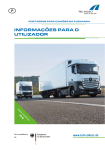
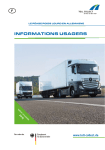
![[Hier klicken und Text eingeben]](http://vs1.manualzilla.com/store/data/006516100_1-16c7e0013bf3813d5673809a0bc942bc-150x150.png)
